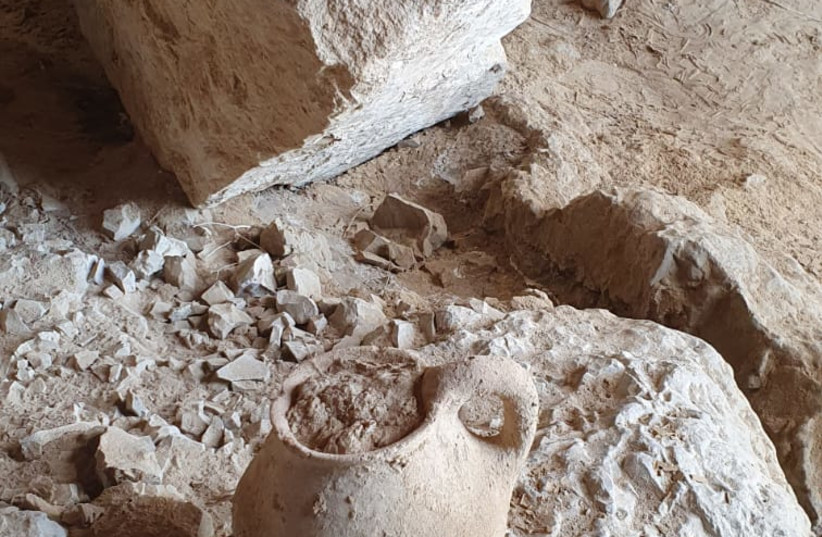Sometimes it just takes the right person in the right place at the right time.
Recently, American tourist Robbie Brown was that person.
Having returned for a visit to Israel with friends following the lifting of COVID-19 travel restrictions, Brown asked for special permission to visit the site of an archaeological dig in the Qumran region near the Dead Sea where five years ago he had volunteered with Dr. Oren Gutfeld of the Hebrew University of Jerusalem and Dr. Randall Price of the University of Liberty in Virginia.
The excavation of cave 53, as the site is called, was theoretically completed in 2017, said the Antiquities Authority (IAA). At the time, archaeologists uncovered shards of jars and bowls that served as lids for jars, dates and olive seeds, and even a blank piece of ancient parchment scroll – even though the cave had been excavated 30 years earlier by the IAA led by Dr. Yigal Israel and the late Dr. Rudolf Cohen, who had found antiquities from the Neolithic and Roman periods.
However, when Brown and his friends climbed into the cave located 100 meters above the road line, they were stunned to find the remains of a fallen wall, and right next to it an entire, 5,000-year-old pottery jug.

Having taken part in the excavations of the cave, Brown knew to photograph the jug without moving it or touching it, and contacted the IAA. Amir Ganor, the IAA’S director of the robbery prevention unit, came right out to the site with Gutfeld and Aviam Atar, the Nature and Parks Authority district director.
“It’s amazing,” said Ganor, noting that the cave was part of a survey of Judean Desert caves conducted two years ago by IAA archaeologists, intended to document and locate all ancient finds in the desert caves in an attempt to thwart antiquity thefts.
“It seems that the jar was revealed as a result of the natural collapse of a part of the cave wall at the cave entrance, which can happen over time. This is perhaps the first complete vessel we have found from this period in the caves in the Judean Desert.”
During their cave survey, pottery shard remains were found from the Early Bronze Age, he added.
“It is good that the person who entered the cave was Robbie, who participated in the excavation and is aware of the importance of the finds and their role in completing the archaeological puzzle of the Land of Israel,” said Ganor. “We call on citizens who discover artifacts to leave them in place and call us immediately so that we can maximize the archaeological information from the find.”
Ganor added that climbing without authorization in the cliff areas of the Judean Desert is dangerous and forbidden by law.
The clay jug was removed from the cave and will be scientifically analyzed.
SOME 972 TEXTS dating to the first and second centuries BCE, including the oldest known existing copy of the Old Testament, were discovered in the Qumran caves in this same area in the early years of Israel’s statehood. Since then, thousands of fragments have been found. The majority are written in ancient Hebrew while others are written in Aramaic and Greek.
The first seven scrolls were discovered in clay jars in 1947, according to the traditional story, by a young Bedouin shepherd chasing after one of his goats. What ensued was a thriller-worthy race to purchase the scrolls, and later excavate the area, after an antique dealer who had bought the scrolls from the Bedouin showed part of a scroll to Hebrew University Professor Elazar Sukenik on the eve of Israeli independence. Sukenik managed to buy three of the scrolls before war broke out, and Israel later bought others following the war.
Due to the dry climate of the Dead Sea area, the scrolls were well preserved. They are thought to have been written by members of the Essene Jewish sect living in a community at the bottom of the mountains where the caves are located. Remains from the community were also uncovered in excavations. In addition to shedding light on Jewish life during that period, the scrolls have also provided scholars with information on the emergence of early Christianity.
The first seven scrolls discovered are on display at the specially-constructed Shrine of the Book at the Israel Museum in Jerusalem.
Ownership of the scrolls has been contested by Jordan, which had sovereignty over the Qumran area until 1967, and in 2010 when the scrolls were on exhibit in Canada, Jordan demanded that Israel hand over some that had previously been housed in the Rockefeller Museum in east Jerusalem. Following the Six-Day War, Israel relocated the scrolls to the Shrine of the Book.
Canada and other countries rejected Jordan’s requests that they seize the scrolls when they have been on exhibit in museums abroad.
Israel’s Foreign Ministry told The Jerusalem Post at the time of Jordan’s demand, “Jordan’s occupation of the West Bank was never recognized by the international community, and the kingdom relinquished all claims on the territories. The scrolls have no relation to Jordan or the Jordanian people.”
Other scroll fragments including a complete scroll known as the Copper Scroll – which was found in early excavations but believed to be from a different period than the other scrolls – are on exhibit in a climate-controlled display in the Jordan Museum. The Copper Scroll is made of metal and contains a list of places where gold and silver items are hidden, and has been used as a map by treasure hunters.
